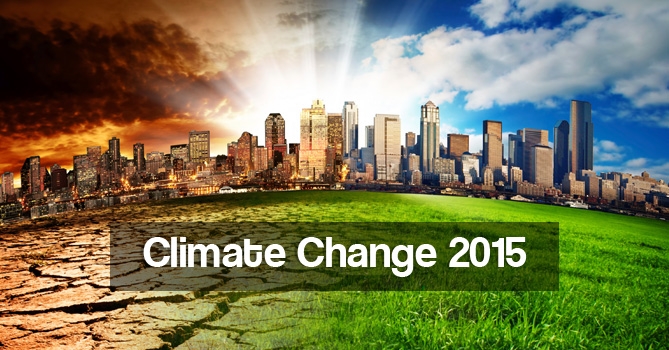The world awaits the final text release that will spell out what exactly negotiators at Paris, representing over 192 countries, have agreed upon on how they plan to tackle the problem of climate change going forward.
The agenda of the Summit (30 November – 11 December 2015)
- To bridge the perception gap between developed and developing nations on what is a mutually acceptable goal and to agree upon the process mechanisms for achieving those.
- To negotiate and agree upon measurable targets with a specific timeline to reduce greenhouse gas emissions.
- To agree upon the financial compensation to developing and underdeveloped nations for achieving the stated goals for emission reduction.
- To agree upon the technology transfer mechanism to enable faster transition towards reducing greenhouse gas reduction.
Planet Earth has been experiencing a rise of 0.85°C in its surface temperature over the last hundred years with 13 of the 14 warmest years ever recorded occurring in this century. And, 2015 has been recorded as the warmest year ever.
The result? Extreme weather patterns that included severe floods caused by excessive rains, extreme dry weather causing severe drought and heatwave, and rising sea levels that are threatening the existence of many low lying islands, especially in the Pacific Ocean. These extreme weather patterns have caused major losses in crop production along with soil degradation, loss of green cover, besides severe financial loss to local economies.
The global scientific community agrees that the major cause for this climate change is the excessive generation and release of gases, mainly carbon dioxide (CO2), into the atmosphere by the energy, industrial and transportation sectors. In 1960, the CO2 concentration i.e. parts per million (ppm), was recorded at 320 ppm – in 2015, it stands at 405 ppm, the highest ever. [You may also know – List of Countries by CO2 Emissions ]
Processing of fossil fuels like oil, coal and natural gas is also contributing to the gases being trapped in the atmosphere, thereby causing a greenhouse effect. This in turn, is resulting in global warming that is attributed as the prime factor behind extreme weather patterns, especially in this century.
Forests absorb the CO2 from the atmosphere and loss of this vital green cover, resulting from excessive deforestation, is further adding to the problem.
The Top 10 major contributors to Greenhouse Gas Emissions (excluding land use change and forestry)
Over seventy per cent of the global greenhouse gas emission is generated by the following countries:
- China: 24%
- United States: 12%
- European Union: 9 %
- India: 6%
- Brazil: 6%
- Russia: 5%
- Japan: 3%
- Canada: 2%
- Democratic Republic of Congo: 1.5%
- Indonesia: 1.5%
The conflict between developed and developing nations
Developing countries like China and India are pursuing rapid expansion of their economies and require cheap energy to fuel this expansion. Fossil fuels offer a cheap source of energy which is abundantly available in both these countries. As they expand their fossil fuel based energy generating capacities, they are also increasing their contribution to the global warming phenomenon.
This is a path already taken by developed countries who grew their respective economies over rapid industrialization and therefore, have been the biggest contributor to the greenhouse gas effect. On the back of scientific studies, the global community has now reached a broad consensus on the cause of global climate change and the need to address this issue on a priority basis.
The developed countries led by the US and the EU, believe that all countries must set a common target in reducing greenhouse gas release by curbing the use of fossil fuel. The developing countries, on the other hand, led by China and India, feel that they have the right to rapidly develop their respective economies and need fossil fuel driven cheap energy to drive this growth. Their position is that developed countries caused the problem in the first place and must now pay or compensate the developing countries for the additional cost that they must bear for reducing greenhouse gas emissions.
Since the first Conference of Parties (COP) in 1995 under the UNFCC, the global community has been engaged in hectic annual negotiations under the COP initiative but have not come to a final agreement till date. COP 21, held in Paris, is widely expected to arrive at a global consensus on emission reduction targets and the process to achieving those.
Major points of contention
Developing countries are insisting on including the term ‘differentiation’ to demarcate the developed from the developing countries in target setting, implementation, monitoring and compensation. The developed nations are opposing the ‘differentiation’ clause being insisted by India, and supported by China.
Setting the goal is another point of debate between nations. Differing views exist on whether the goal should be to restrict emissions to 2° C, 1.5° C or ‘well-below 2° C’, over the emissions during the pre-industrial days. The US has been pushing for keeping the cap at 1.5° C above the base date, as the peak level and would like to advance the date.
The cost involved in reducing greenhouse emissions is significant and unaffordable for most underdeveloped countries. The level and mechanism for financing the process of changeover and monitoring the progress is another major point of dispute.
US Secretary of State John Kerry has been leading the US negotiations and has warned the global community that any deal that involves heavy financial outflow on part of the US will be unacceptable, as there was a serious threat of a repeat of the Kyoto Protocol fiasco when President Clinton signed the treaty only to be rejected by the Congress.
The challenges ahead
If an agreement is finally reached in Paris, it will be formally signed next year in New York in April 2016 and will become operational by 2020. All nations will be obliged to submit their respective national goals and meeting their time bound emission reduction targets.
The biggest challenge is to support the developing and underdeveloped countries with efficient technology transfer that will help mitigate greenhouse gas emissions. What is still not clear is who will finance this changeover, by what extent, and through which mechanism. Paris is unlikely to come up with a clear and detailed roadmap to address all issues and these will have to be addressed well before the operational year of 2020.
For countries like India and China, the tradeoff between national development and healthy population will be a challenge and they will have to remain engaged with the global community to figure out a way forward without being isolated. Brazil has already announced its decision to join the climate ‘ambition coalition’ group that is a new formation being promoted by the US at Paris and is threatening to isolate India and China for the position they have taken till now.
Meanwhile, a cautiously optimistic global community awaits the final COP 21 resolution.

